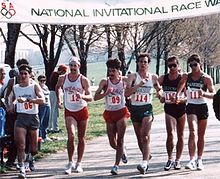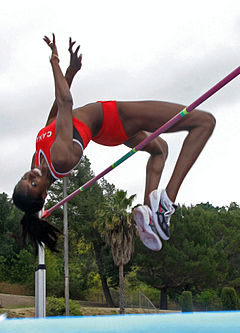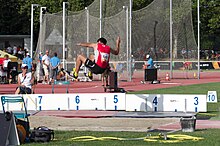Portal:Sport of athletics/Selected article
Selected article 1
Portal:Sport of athletics/Selected article/1

The United States national olympic athletics (track and field) team represents the United States in international athletics competitions such as the Olympic Games or the World Athletics Championships. (Full article...) The United States is the nation that has won the most medals in athletics at the Olympic Games, around 795, of which 332 are gold.[1] Their national-level male, took part in all editions of the games already this season, 25 with the exception of Moscow 1980 known for the 1980 boycott, while women 18 editions from Amsterdam 1928.[2]
| More selected articles |
Selected article 2
Portal:Sport of athletics/Selected article/2
The 100 metres, or 100-meter dash, is a sprint race in track and field competitions. The shortest common outdoor running distance, the 100-meter (109.36 yd) dash is one of the most popular and prestigious events in the sport of athletics. It has been contested at the Summer Olympics since 1896 for men and since 1928 for women. The inaugural World Championships were in 1983.
On an outdoor 400-metre running track, the 100 m is held on the home straight, with the start usually being set on an extension to make it a straight-line race. There are three instructions given to the runners immediately before and at the beginning of the race: "on your marks", "set", and the firing of the starter's pistol. The runners move to the starting blocks when they hear the 'on your marks' instruction. The following instruction, to adopt the 'set' position, allows them to adopt a more efficient starting posture and isometrically preload their muscles: this will help them to start faster. A race-official then fires the starter's pistol to signal the race beginning and the sprinters stride forwards from the blocks. Sprinters typically reach top speed after somewhere between 50 and 60 m. Their speed then slows towards the finish line.
The 10-second barrier has historically been a barometer of fast men's performances, while the best female sprinters take eleven seconds or less to complete the race. The men's world record is 9.58 seconds, set by Jamaica's Usain Bolt in 2009, while the women's world record is 10.49 seconds, set by American Florence Griffith-Joyner in 1988. (Full article...)
| More selected articles |
Selected article 3
Portal:Sport of athletics/Selected article/3
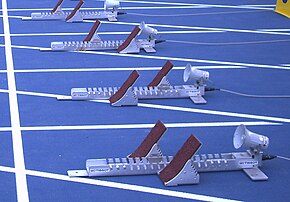
Starting blocks are a device used in the sport of track and field by sprint athletes to brace their feet against at the start of a race so they do not slip as they stride forward at the sound of the starter's pistol. The blocks also enable the sprinters to adopt a more efficient starting posture and isometrically preload their muscles in an enhanced manner. This allows them to start more powerfully and increases their overall sprint speed capability.
For most levels of competition, including the whole of high-level international competition, starting blocks are mandatory equipment for the start of sprint races. Their invention is credited to Australian Charlie Booth and his father in 1929. Prior to this, runners would dig holes in the dirt track. Trowels were provided at the start of races. This was not the most consistent or stable system. It also was destructive to the track surface with the holes having to be filled for subsequent runners. When George Simpson became the first person to run 9.4 seconds for the 100-yard dash in 1930, his record was disallowed because he used starting blocks.
Modern blocks used for world records now must have sensors that detect the pressure from the athlete and can be used to time their reaction to the starting gun. Athletes who react faster than one-tenth of a second can be charged with a false start and the race recalled. Many also carry electronic speakers so the sound of the gun arrives at the ears of the athletes at exactly the same time. Some races for hearing-impaired athletes have also used starting light systems, similar to motorsport's Christmas Tree. (Full article...)
| More selected articles |
Selected article 4
Portal:Sport of athletics/Selected article/4

The Chicago Marathon is a road marathon held in October in Chicago, Illinois. It is one of the seven World Marathon Majors. Thus, it is also a World Athletics Label Road Race. The Chicago Marathon is one of the largest races by number of finishers worldwide. The race was awarded the World Athletics Heritage Plaque in 2024, for "outstanding contribution to the history and development of road running."
Annual Chicago marathons were held from 1905 to the 1920s, but the first race in the present series occurred on September 25, 1977, under the original name the Mayor Daley Marathon, which drew a field of 4,200 runners. The race has been held every year since, except in 1987 when only a half-marathon was run, and in 2020 as a result of the COVID-19 pandemic. It became among the fastest-growing modern-marathon road races in the world, due in part to its largely fast and flat course which facilitates the pursuit of personal records and world record performances. It generally begins and ends in Grant Park, and travels streets of the North Side, West Side and South Side, before returning to the Loop. The race has achieved its elite status among marathons by developing relationships with sponsors who provide prize money to lure elite runners who have produced American and world record performances. Since 2008, the race has been sponsored and organized by Bank of America, and is officially known as the Bank of America Chicago Marathon. (Full article...)
| More selected articles |
Selected article 5
Portal:Sport of athletics/Selected article/5

Masters Athletics managed by World Masters Athletics is a class of the sport of athletics for athletes of 35 years of age and over organized by World Masters Athletics. The events include track and field, road running and cross country running. Competitors are bracketed into five-year age groups (which promotes fair competition). For international events the first age group is 35 to 39. Men as old as 105 and women in their 100s have competed in running, jumping and throwing events. Masters athletes are sometimes known as "veterans" and the European Masters Championships, for instance, is known as "Eurovets". This and other high level events including biennial World Championships cater largely to elite-level athletes, but many masters athletes are novices to athletics and enjoy the camaraderie offered by masters competition at the local, National and International level. Most National governing bodies for track and field hold annual Masters championships. Prestigious National meets such as the Penn Relays and the United States Olympic Trials (track and field) put on exhibition events for top masters athletes. Masters athletics is growing Internationally with over 6000 athletes competing at recent World Championships. World; National and Regional records are maintained for each age group.
In India the Masters Athletics Federation of India conducts National Masters Athletics Championships every year. In the United States, USATF (USA Track & Field) hosts various Masters events including National Championships for Indoor and Outdoor Track & Field and Cross Country. USATF adds the age divisions 30–34 as Sub-Masters, and 25–29 as Pre-Masters to give athletes just past college age more opportunities to compete. (Full article...)
| More selected articles |
Selected article 6
Portal:Sport of athletics/Selected article/6
The men's marathon race of the 1908 Summer Olympics took place in London on 24 July 1908. Johnny Hayes won after Dorando Pietri was disqualified for having received assistance before the finish line. For the first time in an Olympic marathon, the distance was 26 mi 385 yd (42.195 km), which would become the standard distance in 1921. 75 competitors entered the race, of whom 55 from 16 nations started, with 27 from 11 nations finishing. NOCs could enter up to 12 athletes. Charles Hefferon's silver medal earned South Africa its first Olympic marathon medal. (Full article...)
| More selected articles |
Selected article 7
Portal:Sport of athletics/Selected article/7

Chariots of Fire is a 1981 historical sports drama film directed by Hugh Hudson, written by Colin Welland and produced by David Puttnam. It is based on the true story of two British athletes in the 1924 Olympics: Eric Liddell, a devout Scottish Christian who runs for the glory of God, and Harold Abrahams, an English Jew who runs to overcome prejudice. Ben Cross and Ian Charleson star as Abrahams and Liddell, alongside Nigel Havers, Ian Holm, John Gielgud, Lindsay Anderson, Cheryl Campbell, Alice Krige, Brad Davis and Dennis Christopher in supporting roles. Kenneth Branagh and Stephen Fry make their debuts in minor roles.
Chariots of Fire was nominated for seven Academy Awards and won four, including Best Picture, Best Original Screenplay and Best Original Score for Vangelis's electronic theme tune. At the 35th British Academy Film Awards, the film was nominated in 11 categories and won in three, including Best Film. It is ranked 19th in the British Film Institute's list of Top 100 British films. (Full article...)
| More selected articles |
Selected article 8
Portal:Sport of athletics/Selected article/8

Tartan track is a trademarked all-weather synthetic track surfacing made of polyurethane used for track and field competitions, manufactured by 3M. The original production was in 1967, and the product was later reformulated to eliminate the use of mercury.
Because the "Tartan" product was widely successful in its time, the name Tartan has been used as a genericized trademark for description of an all-weather running track.[original research?]
Athletic Polymer Systems, a subsidiary of MCP Industries, Inc., manages the installation of Tartan-branded running track. (Full article...)
| More selected articles |
Selected article 9
Portal:Sport of athletics/Selected article/9
Race walking, or racewalking, is a long-distance discipline within the sport of athletics. Although a foot race, it is different from running in that one foot must appear to be in contact with the ground at all times. Race judges carefully assess that this is maintained throughout the race. Typically held on either roads or running tracks, common distances range from 3,000 metres (1.9 mi) up to 100 kilometres (62.1 mi).
The current race walking contests at the Summer Olympics are the 20 kilometres race walk (men and women) and the marathon race walk mixed relay, the latter of which debuted at the 2024 Summer Olympics. The 50 kilometres race walk (men only) was discontinued after the 2020 Summer Olympics. The biennial World Athletics Championships also features both 20 and 50 kilometer events, the 50 km walk for women being contested until 2019. The 50 km race walk was replaced by the 35 kilometres race walk as standard championship discipline in 2022. The IAAF World Race Walking Cup, first held in 1961, is a stand-alone global competition for the discipline and it has 10 kilometres race walks for junior athletes, in addition to the Olympic-standard events. The IAAF World Indoor Championships featured 5000 m and 3000 m race walk variations, but these were discontinued after 1993. Top-level athletics championships and games typically feature 20 km racewalking events. (Full article...)
| More selected articles |
Selected article 10
Portal:Sport of athletics/Selected article/10
The high jump is a track and field event in which competitors must jump unaided over a horizontal bar placed at measured heights without dislodging it. In its modern, most-practiced format, a bar is placed between two standards with a crash mat for landing. Since ancient times, competitors have successively improved their technique until developing the universally preferred Fosbury Flop, in which athletes run towards the bar and leap head first with their back to the bar.
The discipline is, alongside the pole vault, one of two vertical clearance events in the Olympic athletics program. It is contested at the World Championships in Athletics and the World Athletics Indoor Championships, and is a common occurrence at track and field meets. The high jump was among the first events deemed acceptable for women, having been held at the 1928 Olympic Games.
Javier Sotomayor (Cuba) is the world record holder with a jump of 2.45 m (8 ft 1⁄4 in) set in 1993 – the longest-standing record in the history of the men's high jump. Yaroslava Mahuchikh (Ukraine) is the women's world record holder with a jump of 2.10 m (6 ft 10+1⁄2 in) set in 2024. (Full article...)
| More selected articles |
Selected article 11
Portal:Sport of athletics/Selected article/11

The IAAF Hall of Fame was established by the International Association of Athletics Federations (since 2019: World Athletics) in 2012. It is intended to honor individuals who have made valuable contributions in the sport of athletics both internationally and in their home countries that match certain criteria.
The inaugural class, composed of 24 individuals, was introduced in November 2012. (Full article...)
| More selected articles |
Selected article 12
Portal:Sport of athletics/Selected article/12
The long jump is a track and field event in which athletes combine speed, strength and agility in an attempt to leap as far as possible from a takeoff point. Along with the triple jump, the two events that measure jumping for distance as a group are referred to as the "horizontal jumps". This event has a history in the ancient Olympic Games and has been a modern Olympic event for men since the first Olympics in 1896 and for women since 1948. (Full article...)

There are five main components of the long jump: the approach run, the last two strides, takeoff, action in the air, and landing. Speed in the run-up, or approach, and a high leap off the board are the fundamentals of success. Because speed is such an important factor of the approach, it is not surprising that many long jumpers also compete successfully in sprints. Classic examples of this long jump / sprint doubling are performances by Carl Lewis and Heike Drechsler.
| More selected articles |
Selected article 13
Portal:Sport of athletics/Selected article/13 The 2010 IAAF World Half Marathon Championships was held in Nanning, China on 16 October 2010. The competition took place on the city streets, beginning and ending at Wuxiang Square, with a total prize purse of US$245,000 at stake.
The Kenyan athletes emerged with both the individual and team titles in the men's and women's races. Despite limited experience in top level half marathon races, Wilson Kiprop and Florence Kiplagat won their respective races. Kiprop broke Zersenay Tadese's winning streak which dated back to 2006, out-sprinting the defending champion in the final stages. Sammy Kitwara won the men's bronze medal and helped Kenya to the men's team title. Led by Zersenay, the Eritrean men beat Ethiopia to the team silver medal spot.
A total of 30 countries were represented at the 19th edition of the competition and 123 runners altogether were entered into the men's and women's races. The event was the final edition to be held on an annual schedule, as the competition switched to a biennial format for the 2012 championships. (Full article...)
| More selected articles |
Selected article 14
Portal:Sport of athletics/Selected article/14 Race Walking Record (abbreviated RWR) is a nonprofit magazine about the sport of race walking, and walking events, primarily aimed at a UK audience. The magazine was founded in London in 1941 by Alf McSweeney in order to keep athletes serving as soldiers in World War II informed about their sport back home. Alf McSweeney was president of the Race Walking Association at the time, and a printer by trade.
Race Walking was a successful Olympic sport for Great Britain at that time. After producing the first issue, the magazine soon became popular. It continues to be produced each month after more than 800 issues in over seventy years. (Full article...)
| More selected articles |
Selected article 15
Portal:Sport of athletics/Selected article/15

World Athletics, formerly known as the International Amateur Athletic Federation and International Association of Athletics Federations and formerly abbreviated as the IAAF, is the international governing body for the sport of athletics, covering track and field, cross country running, road running, race walking, mountain running, and ultra running. Included in its charge is the standardization of rules and regulations for the sports, certification of athletic facilities, recognition and management of world records, and the organisation and sanctioning of athletics competitions, including the World Athletics Championships. The organisation's president is Sebastian Coe of the United Kingdom, who was elected to the four-year position in 2015 and re-elected in 2019 for a second four-year term, and then again in 2023 for a third four-year term. (Full article...)
| More selected articles |
Selected article 16
Portal:Sport of athletics/Selected article/16
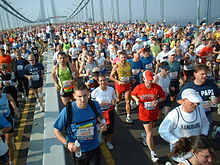
The New York City Marathon, currently branded as the TCS New York City Marathon for sponsorship reasons, is an annual marathon (42.195 km or 26.219 mi) that courses through the five boroughs of New York City. It is the largest marathon in the world, with 53,627 finishers in 2019 and 98,247 applicants for the 2017 race. Along with the Boston Marathon and Chicago Marathon, it is among the pre-eminent long-distance annual running events in the United States and is one of the World Marathon Majors.
The race is organized by New York Road Runners and has been run every year since 1970, with the exception of 2012, when it was cancelled due to the landfall of Hurricane Sandy, and 2020, when it was cancelled due to the COVID-19 pandemic. The race is held on the first Sunday of November and attracts professional competitors and amateurs from all over the world. Because of the popularity of the race, participation is chosen largely by a lottery system. Guaranteed entry to the marathon can be gained by satisfying the requirements of the 9+1 program or the 9+$1K program (where NYRR members run in nine sponsored races and either volunteer at another event or donate $1,000 to support NYRR programs for young athletes), having completed 15 or more previous NYC Marathons, or meeting time qualification standards. In addition, runners can gain an entry by joining a team to raise funds for one of a number of charities. (Full article...)
| More selected articles |
Selected article 17
Portal:Sport of athletics/Selected article/17

Sprinting is running over a short distance at the top-most speed of the body in a limited period of time. It is used in many sports that incorporate running, typically as a way of quickly reaching a target or goal, or avoiding or catching an opponent. Human physiology dictates that a runner's near-top speed cannot be maintained for more than 30–35 seconds due to the depletion of phosphocreatine stores in muscles, and perhaps secondarily to excessive metabolic acidosis as a result of anaerobic glycolysis.
In athletics and track and field, sprints (or dashes) are races over short distances. They are among the oldest running competitions, being recorded at the Ancient Olympic Games. Three sprints are currently held at the modern Summer Olympics and outdoor World Championships: the 100 metres, 200 metres, and 400 metres. (Full article...)
| More selected articles |
Selected article 18
Portal:Sport of athletics/Selected article/18

A starting pistol or starter pistol is a blank handgun or, more recently, an electronic toy gun or device with a button connected to a sound system that is fired to start track and field races as well as some competitive swimming races. Traditional starter guns cannot fire real ammunition without first being extensively modified: Blank shells or caps are used to prevent expelling projectiles, and only a small amount of smoke can be seen when shot. In most places, trying to modify the replica is illegal.
Starting pistols may also include modified versions of standard pistols incapable of firing bullets, most commonly achieved by welding an obstruction into the barrel. This is less common nowadays, especially in Western countries. When electronic timing is used, a sensor is often affixed to the gun, which sends an electronic signal to the timing system upon firing. For deaf competitors or for modern electronic systems, the electronic toy gun sends off a light signal, with some events using a light system. (Full article...)
| More selected articles |
Selected article 19
Portal:Sport of athletics/Selected article/19

A pacemaker or pacesetter, sometimes informally called a rabbit, is a runner who leads a middle- or long-distance running event for the first section to ensure a high speed and to avoid excessive tactical racing. Pacemakers are frequently employed by race organisers for world record attempts with specific instructions for lap times. Some athletes have essentially become professional pacemakers. A competitor who chooses the tactic of leading in order to win is called a front-runner rather than a pacemaker.
Pacemakers may be used to avoid the tactics of deception that are possible in competition by those who, for example, race away from the start line (and are likely to subsequently slow down), giving the other runners the impression that they are far behind. A trusted team of pacemakers who are paid to keep the runners at a speed that they can manage for the rest of the race become useful in such a situation. Pacemakers are also used on world record attempts in order to make sure that the runner knows where their invisible "opponent" predecessor is at that stage of the race. Pacemakers serve the role of conveying tangible information about pacing on the track during a race. Pacemakers may also facilitate drafting.
Pacemakers are also used for amateurs to assist them in reaching personal goals. For example, in a marathon there may be pacemakers for 3 hours, 3:30, 4 hours, etc. Such pace-setters are referred to as a pacing bus or bus in South African races.
Flashing lights in the side of tracks set to a specific pace were an innovation introduced in 1972 by the professional International Track Association to provide visual excitement to their races. They became commonly used in major competitions (aside from championship meets) around 2023. (Full article...)
| More selected articles |
Selected article 20
Portal:Sport of athletics/Selected article/20

The World Athletics Awards is a prize that can be won by athletes participating in events within the sport of athletics organised by World Athletics (formerly named IAAF), including track and field, cross country running, road running, and racewalking.
The first athletes awarded World Athlete of the Year in 1988 were Americans, namely sprinter Florence Griffith-Joyner and track and field athlete Carl Lewis.
Jamaican sprinter Usain Bolt is the only athlete, male or female, to win the World Athlete of the Year Awards six times. Russian pole vaulter Yelena Isinbayeva and Morocco's middle-distance runner Hicham El Guerrouj have won the main award three times. Swedish pole vaulter Armand Duplantis has also won the award three times including the inaugural World Athlete of the Year (Men's field) award in 2023 after World Athletics Awards changed from crowning a sole male and female winner to issuing awards across six categories (see below for further details). American track and field athlete Marion Jones, sprinter Sanya Richards-Ross representing the USA, Carl Lewis and other American sprinter Michael Johnson, Ethiopia's long-distance runner Kenenisa Bekele, Kenya's long-distance runner Eliud Kipchoge and Venezuela's triple-jumper Yulima Rojas have won the award twice each.
The Rising Star of the Year award was inaugurated in 1998, when Great Britain's sprinter Christian Malcolm was awarded. The first woman to be voted was 400 m and 400 m H specialist, Jana Pittman of Australia, in 2000.
Ethiopian long-distance runner Kenenisa Bekele was the first to receive Rising Star award followed by Athlete of the Year trophy in 2003 and 2004 respectively. The other athletes to achieve the feat were Jamaican sprinter Usain Bolt, American sprinter Allyson Felix, Belgian heptathlete Nafissatou Thiam, Venezuelan triple jumper Yulimar Rojas, American hurdler and sprinter Sydney McLaughlin-Levron, Swedish pole vaulter Armand Duplantis, and Norwegian hurdler Karsten Warholm. Jamaican sprinter Usain Bolt and American sprinter Erriyon Knighton are the only two athletes to be crowned Rising Star twice. (Full article...)
| More selected articles |
Selected article 21
Portal:Sport of athletics/Selected article/21

The modern Summer Olympic Games have been held every four years since the first Games in 1896 (except 1916 due to the First World War, 1940 and 1944 due to the Second World War, and 2020 due to the COVID-19 pandemic) and Olympic records are recognised by the International Olympic Committee (IOC) in each event. The athletics events, which take place at each Games, are divided into four groups: track events (including sprints, middle- and long-distance running, hurdling and relays), field events (including javelin, discus, hammer, pole vault, long and triple jumps), road events (such as walks and the marathon) and combined events (the heptathlon and the decathlon). Women compete in 23 athletics events during the Games, and men compete in 24; while 21 of the events are the same for both men and women, men exclusively compete in the 50 km walk, the women's combined event is the heptathlon while the men compete in the decathlon, and the short distance hurdles for women is contested over 100 m, ten metres shorter than the men's event.
Some Olympic records have been broken but later rescinded by the IOC. In 1988, Canadian sprinter Ben Johnson broke the Olympic and World record in the 100 metres sprint, but was subsequently disqualified after it was discovered that he had used anabolic steroids to enhance his performance. His record was expunged and the gold medal was instead awarded to original silver medalist American Carl Lewis. Hungarian athlete Róbert Fazekas broke the Olympic record in the men's discus in 2004 but was later stripped of both his gold medal and the record after it was deemed that he had "committed an anti-doping rule violation".
The longest standing modern Olympic athletics record is Bob Beamon's achievement in the men's long jump at the 1968 Summer Olympics. The jump, at 8.90 m (29 ft 2 in), also broke the existing world record by 55 cm (22 in), and stood as the world record for 23 years until Beamon's compatriot, Mike Powell, jumped farther in the 1991 World Championships in Athletics in Tokyo.
Note, only those events currently competed for and recognised by the IOC as Summer Olympic events are listed. (Full article...)
| More selected articles |
Selected article 22
Portal:Sport of athletics/Selected article/22
The 1896 Summer Olympics (Greek: Θερινοί Ολυμπιακοί Αγώνες 1896, romanized: Therinoí Olympiakoí Agónes 1896), officially known as the Games of the I Olympiad (Greek: Αγώνες της 1ης Ολυμπιάδας, romanized: Agónes tis 1is Olympiádas) and commonly known as Athens 1896 (Greek: Αθήνα 1896), were the first international Olympic Games held in modern history. Organised by the International Olympic Committee (IOC), which had been created by French aristocrat Pierre de Coubertin, the event was held in Athens, Greece, from 6 to 15 April 1896.
Fourteen nations (according to the IOC, though the number is subject to interpretation) and 241 athletes (all males; this number is also disputed) took part in the games. Participants were all European or living in Europe, with the exception of the United States team, and over 65% of the competing athletes were Greek. Winners were given a silver medal, while runners-up received a copper medal. Retroactively, the IOC has converted these to gold and silver, respectively, and awarded bronze medals to third-placed athletes. Ten of the 14 participating nations earned medals. On April 6, 1896, American James Connolly became the first Olympic medalist in more than 1,500 years, competing in the triple jump. The United States won the most gold medals, 11, while host nation Greece won the most medals overall, 47. The highlight for the Greeks was the marathon victory by their compatriot Spyridon Louis. The most successful competitor was German wrestler and gymnast Carl Schuhmann, who won four events.
The 1896 Olympics were regarded as a great success. The Games had the largest international participation of any sporting event to that date. The Panathenaic Stadium overflowed with the largest crowd ever to watch a sporting event. After the Games, Coubertin and the IOC were petitioned by several prominent figures, including Greece's King George and some of the American competitors in Athens, to hold all the following Games in Athens. However, the 1900 Summer Olympics were already planned for Paris, and, with the exception of the Intercalated Games of 1906, the Olympics did not return to Greece until the 2004 Summer Olympics, 108 years later. (Full article...)
| More selected articles |
Selected article 23
Portal:Sport of athletics/Selected article/23

The Night of Legends Award, is an annual track and field award that is the highest accolade given out by USA Track & Field (USATF). The male athlete of the year award was named Jesse Owens Award. As the country's highest award for the sport, it bears Jesse Owens's name in recognition of his significant career, which included four gold medals at the 1936 Olympic Games. First awarded in 1981 to hurdler Edwin Moses, it was created to recognize the season's top American performer in track and field competitions. In 1996, the award was divided into two categories, with both a male and female winner. The 1996 winners, Michael Johnson and Gail Devers, each won two gold medals at that year's Olympics in Atlanta. Until 2008 the award was voted on by members of the United States athletics media only, but in 2009 fans were able to vote via the USATF website, with their opinions contributing 10% of the overall result.
The winners of the award are typically announced in late November or early December after the end of the outdoor track and field season. A number of athletes have received the award on more than one occasion: Jackie Joyner-Kersee was the first to do so with back-to-back wins in 1986 and 1987, while Carl Lewis won his second award in 1991. Michael Johnson was the first to receive the award three times (winning consecutively from 1994 to 1996) and Marion Jones became the first woman to collect three awards after wins in 1997, 1998 and 2002. In 2012, Allyson Felix won the award for the fourth time, thus distinguishing herself as the athlete with the most wins. Winners receive a replica of the award while the original remains on permanent display at the USATF Headquarters in Indianapolis, Indiana. As of 2013, the female athlete of the year award was renamed the Jackie Joyner-Kersee Award. (Full article...)
| More selected articles |
Selected article 24
Portal:Sport of athletics/Selected article/24 USA Track & Field (USATF) is a United States national governing body for the sports of track and field, cross country running, road running, and racewalking (known as the sport of athletics outside the US). The USATF was known between 1979 and 1992 as The Athletics Congress (TAC) after its spin-off from the Amateur Athletic Union (AAU), which governed the sport in the US through most of the 20th century until the Amateur Sports Act of 1978 dissolved its responsibility. Based in Indianapolis, USATF is a non-profit organization with a membership of more than 130,000. The organization has three key leadership positions: CEO Max Siegel, Board of Directors Chair Steve Miller, and elected president Vin Lananna. U.S. citizens and permanent residents can be USATF members (annual individual membership fee: $30 for 18-year-old members and younger, $55 for the rest), but permanent residents can only participate in masters events in the country, and they cannot win USATF medals, prize money, or score points for a team, per World Athletics regulations.
USA Track & Field is involved in many aspects of the sport at the local, national, and international level, providing the rules, officials, coaching education, sports science and athlete development, youth programs, masters (age 25+) competition, the National Track and Field Hall of Fame, and an annual meeting. It also organizes the annual USA Track and Field Outdoor Championships, the USA Track & Field Indoor Championships, the USA Cross Country Championships, the USATF National Club Cross Country Championships, and the USATF National Club Track & Field Championships. Through its sanctioning program, the national body provides the insurance coverage necessary for members to rent facilities, thus allowing for competitive opportunities for all athletes to happen. USA Track and Field has held National conventions since the 1870s or 1880s. NAAA Track and Field Championship and Convention locations Dec 3–6, 2020, virtually; earlier announced the 2020 USATF Annual Meeting to be held virtually instead of face-to-face. (Full article...)
| More selected articles |
Selected article 25
Portal:Sport of athletics/Selected article/25
The shot put is a track and field event involving "putting" (throwing) a heavy spherical ball—the shot—as far as possible. For men, the sport has been a part of the modern Olympics since their revival (1896), and women's competition began in 1948. (Full article...)
| More selected articles |
Selected article 26
Portal:Sport of athletics/Selected article/26

The hammer throw is one of the four throwing events in regular outdoor track and field competitions, along with the discus throw, shot put and javelin.
The hammer used in this sport is not like any of the tools also called by that name. It consists of a metal ball attached by a steel wire to a grip. These three components are each separate and can move independently. Both the size and weight of the ball vary between men's and women's events. The women's hammer weighs 4 kilograms (8.8 lb) for college and professional meets while the men's hammer weighs 7.26 kilograms (16.0 lb). (Full article...)
The men's hammer weighs 7.26 kilograms (16.0 lb) and the women's weighs 4 kg (8.8 lb), with the wire in either case no more than 122 centimetres (48 in) in length.[3] Like the other throwing events, the competition is decided by who can throw the implement the farthest.
The throwing motion starts with the thrower swinging the hammer back-and-forth about two times to generate momentum. The thrower then makes three, four or (rarely) five full rotations using a complex heel-toe foot movement, spinning the hammer in a circular path and increasing its angular velocity with each rotation. Rather than spinning the hammer horizontally, it is instead spun in a plane that angles up towards the direction in which it will be launched. The thrower releases the hammer as its velocity is upward and toward the target.[4]
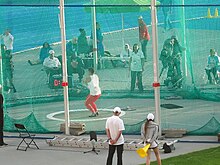
Throws are made from a throwing circle. The thrower is not allowed to step outside the throwing circle before the hammer has landed and may only enter and exit from the rear of the throwing circle. The hammer must land within a 34.92º throwing sector that is centered on the throwing circle. The sector angle was chosen because it provides a sector whose bounds are easy to measure and lay out on a field (10 metres out from the center of the ring, 6 metres across).[5][6] A violation of the rules results in a foul and the throw not being counted.[citation needed]
| More selected articles |
Selected article 27
Portal:Sport of athletics/Selected article/27
Track and field is a sport that includes athletic contests based on running, jumping, and throwing skills. The name used in North America is derived from where the sport takes place, a running track and a grass field for the throwing and some of the jumping events. Track and field is categorized under the umbrella sport of athletics, which also includes road running, cross country running and racewalking. In British English the term athletics is synonymous with American track and field and includes all jumping events. Outside of Canada and the United States, athletics is the official term for this sport with 'track' and 'field' events being subgroups of athletics events.
Track and field is one of the oldest sports. In ancient times, it was an event held in conjunction with festivals and sports meets such as the Ancient Olympic Games in Greece. In modern times, the two most prestigious international track and field competitions are the athletics competition at the Olympic Games and the World Athletics Championships. World Athletics, formerly known as the International Association of Athletics Federations (IAAF), is the international governing body for the sport of athletics.
Records are kept of the best performances in specific events, at world, continental, and national levels. However, if athletes are deemed to have violated the event's rules or regulations, they are disqualified from the competition and their marks are erased.
In the United States, the term track and field may refer to other athletics events, such as cross country, the marathon, and road running, rather than strictly track-based events. (Full article...)
| More selected articles |
Selected article 28
Portal:Sport of athletics/Selected article/28

Hurdling is the act of jumping over an obstacle at a high speed or in a sprint. In the early 19th century, hurdlers ran at and jumped over each hurdle (sometimes known as 'burgles'), landing on both feet and checking their forward motion. Today, the dominant step patterns are the 3-step for high hurdles, 7-step for low hurdles, and 15-step for intermediate hurdles. Hurdling is a highly specialized form of obstacle racing, and is part of the sport of athletics. In hurdling events, barriers known as hurdles are set at precisely measured heights and distances. Each athlete must pass over the hurdles; passing under or intentionally knocking over hurdles will result in disqualification.
In track races, hurdles are normally 68–107 cm (27–42 in) in height, depending on the age and sex of the hurdler. Events from 50 to 110 meters are technically known as high hurdles races, while longer competitions are low hurdles races. The track hurdles events are forms of sprinting competitions, although the 400 m version is less anaerobic in nature and demands athletic qualities similar to the 800 meters flat race.
A hurdling technique can also be found in the steeplechase, although in this event athletes are also permitted to step on the barrier to clear it. Similarly, in cross country running athletes may hurdle over various natural obstacles, such as logs, mounds of earth, and small streams – this represents the sporting origin of the modern events. Horse racing has its own variant of hurdle racing, with similar principles. (Full article...)
| More selected articles |
Selected article 29
Portal:Sport of athletics/Selected article/29 The World Athletics Indoor Tour, formerly the IAAF World Indoor Tour, is an annual series of indoor track and field meetings, held since 2016. It was designed to create a Diamond League-style circuit for indoor track and field events, to raise the profile of indoor track and field, and replaced the IAAF Indoor Permit Meetings series.
The tour was announced with initially four meetings, three in Europe and one in the United States, leading to the 2016 IAAF World Indoor Championships in Portland, Oregon. Winners of the Tour enjoy similar privileges in relation to World Indoor Championships qualification as Diamond League winners do in relation to the World Athletics Championships. The tour was initially in place for two years.
The Düsseldorf leg was added for the 2017 Tour, and the Stockholm leg was replaced by the International Copernicus Cup, a long-standing indoor event in Torún, Poland. In 2018, the tour became a permanent fixture, and the Meeting Ville de Madrid was added as the sixth event on the tour. For 2020, the tour added a seventh leg in Liévin, France.
In 2021, the tour expanded by introducing three levels of competition: Gold, Silver and Bronze, mirroring the expanded outdoor World Athletics Continental Tour. In 2022, the tour expanded with the fourth tier: Challenger.
The tour is organised to allow for major indoor championships including the World Athletics Indoor Championships and the European Athletics Indoor Championships and, where appropriate, national championships and trials. (Full article...)
| More selected articles |
Selected article 30
Portal:Sport of athletics/Selected article/30 The use of performance-enhancing drugs (doping in sport) is prohibited within the sport of athletics. Athletes who are found to have used such banned substances, whether through a positive drugs test, the biological passport system, an investigation or public admission, may receive a competition ban for a length of time which reflects the severity of the infraction. Athletes who are found to have banned substances in their possession, or who tamper with or refuse to submit to drug testing can also receive bans from the sport. Competitive bans may also be given to athletes who test positive for prohibited recreational drugs or stimulants with little performance-enhancing effect for competitors in athletics. The sports body responsible for determining which substances are banned in athletics is the World Anti-Doping Agency (WADA).
Typically, any athlete who tests positive for banned substances after having served a previous ban receives a lifetime ban from the sport of athletics. Many high-profile sportspeople to receive doping bans have come from the sport of athletics, with significant past cases concerning Ben Johnson, Marion Jones and Tim Montgomery. Furthermore, a number of athletes who underwent state-sponsored doping programmes in East Germany and the Soviet Union between the 1950s and 1980s were competitors in athletics, but the quality of the international anti-doping work was so poor that only one East German athlete ever tested positive. Following allegations of state-sponsored doping in Russia, the IAAF suspended the country's athletes from competition, including the 2016 Summer Olympics. (Full article...)
| More selected articles |
Selected article 31
Portal:Sport of athletics/Selected article/31

The European Athletic Association (more commonly known as European Athletics) is the governing body for athletics in Europe. It is one of the six Area Associations of the world's athletics governing body World Athletics. European Athletics has 51 members and is headquartered in Lausanne.
Originally created in 1932 as a European Committee, it was made into an independent body during the Bucharest conference of 1969. The first European Athletics congress took place in Paris on 6–8 October 1970, with Dutchman Adriaan Paulen elected as its first president. From a volunteer-led organization based in the acting Secretary's home country, European Athletics has developed into a professional organization with a permanent base in Switzerland.
European Athletics runs and regulates several championships and meetings across Europe – both indoor and outdoor. (Full article...)
| More selected articles |
Selected article 32
Portal:Sport of athletics/Selected article/32

The decathlon is a combined event in athletics consisting of 10 track and field events. The word "decathlon" was formed, in analogy to the word "pentathlon", from Greek δέκα (déka, meaning "ten") and ἄθλος (áthlos, or ἄθλον, áthlon, meaning "contest" or "prize"). Events are held over two consecutive days and the winners are determined by the combined performance in all. Performance is judged on a points system in each event, not by the position achieved. The decathlon is contested mainly by male athletes, while female athletes typically compete in the heptathlon.
Traditionally, the title of "World's Greatest Athlete" has been given to the person who wins the decathlon. This began when Gustav V of Sweden told Jim Thorpe, "Sir, you are the world's greatest athlete" after Thorpe won the decathlon at the Stockholm Olympics in 1912.
The event is similar to the pentathlon held at the ancient Greek Olympics, and also similar to a competition called an "all-around", which was contested at the United States amateur championships in 1884. Another all-around was held at the 1904 Summer Olympics. The modern decathlon first appeared at the 1912 Games.
In modern athletics, the 10 events are: 100 metres, 400 metres, 1500 metres, 110 metre hurdles, long jump, high jump, pole vault, discus throw, javelin throw, and shotput. The current official decathlon world record holder is French athlete Kevin Mayer, who scored a total of 9,126 points at the 2018 Décastar in France. (Full article...)
| More selected articles |
Selected article 33
Portal:Sport of athletics/Selected article/33 The European 10,000m Cup is an annual 10,000 metres race for European athletes which was first held in 1997. The competition is organised by the European Athletics Association and first began as the European 10000 Metres Challenge (European 10,000m Challenge till 2005 edition), after the event was removed from the European Cup programme. The competition has roots in the Iberian 10,000 metres Championships – a competition between Spanish and Portuguese athletes that was held between 1991 and 1996 – and the first five editions of the European 10000 Metres Challenge were held in the Iberian Peninsula. The event was first held under its current title in 2005. From 2018, the event has been held as the climax of the Night of 10k PB's event at Parliament Hill, London. (Full article...)
| More selected articles |
Selected article 34
Portal:Sport of athletics/Selected article/34

The pentathlon or women's pentathlon is a combined track and field event in which each woman competes in five separate events over one day (formerly two days). The distance or time for each event is converted to points via scoring tables, with the overall ranking determined by total points. Since 1949 the events have been sprint hurdling, high jump, shot put, long jump, and a flat race. The sprint hurdles distance was 80 m outdoors until 1969 and thereafter 100 m; in indoor pentathlon the distance is 60 m. The flat race was 200 m until 1976 and thereafter 800 m. In elite-level outdoor competition, the pentathlon was superseded in 1981 by the heptathlon, which has seven events, with both 200 m and 800 m, as well as the javelin throw. Pentathlon is still contested at school and masters level and indoors. (Full article...)
| More selected articles |
Selected article 35
Portal:Sport of athletics/Selected article/35
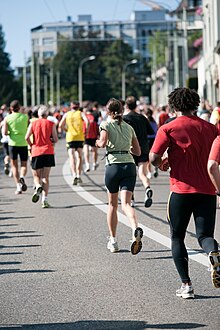
Long-distance running, or endurance running, is a form of continuous running over distances of at least 3 km (1.9 mi). Physiologically, it is largely aerobic in nature and requires stamina as well as mental strength.
In modern human society, long-distance running has multiple purposes: people may engage in it for physical exercise, for recreation, as a means of travel, as a competitive sport, for economic reasons, or cultural reasons. Long-distance running can also be used as a means to improve cardiovascular health. (Full article...)
| More selected articles |
Selected article 36
Portal:Sport of athletics/Selected article/36 A relay race is a racing competition where members of a team take turns completing parts of racecourse or performing a certain action.
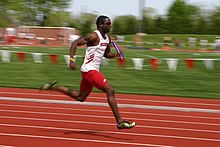
In athletics, the two standard relays are the 4 × 100 metres relay and the 4 × 400 metres relay. 4 × 200, 4 × 800, and 4 × 1500 m relays exist as well, but they are rarer. Mixed-gendered 4 × 400 metres relays were introduced at the 2017 IAAF World Relays, repeated at the 2018 Asian Games, the 2019 World Championships in Athletics and were added to the 2020 Summer Olympics. In addition, a 2 × 2 × 400 m and shuttle hurdles mixed relay races were introduced at the 2019 IAAF World Relays.
Traditionally, the 4 × 400 m relay finals are the last event of a track meet,[citation needed] and is often met with a very enthusiastic crowd, especially if the last leg is a close race.[A] It is hard to measure exact splits in a 4 × 400 (or a 4 × 100) relay. For example, if a team ran a 3-minute 4 × 400, it does not mean every runner on the team has to run a 45-second open 400, because a person starts accelerating before they have the baton, therefore allowing for slightly slower overall open 400 times. A 4 × 400 relay generally starts in lanes for the first leg, including the handoff. The second leg then proceeds to run in lanes for the first 100 metres, after which point the runners are allowed to break into the first lane on the backstretch, as long as they do not interfere with other runners. A race organizer then puts the third-leg runners into a line depending on the order in which they are running (with the first place closest to the inside). The faster teams pass first, while the slower teams have to slide in to the inside lanes as they come available.
According to the IAAF rules, world records in relays can only be set if all team members have the same nationality. Several superior marks were established by teams from a mixture of countries and were thus never ratified.
Selected article 37
Selected article 38
Portal:Sport of athletics/Selected article/38 The Philippine Athletics Track and Field Association (PATAFA) is the National Sports Association (NSA) for athletics sports such as track and field, road running, cross country running, and racewalking in the Philippines, including the core athletics sports which constitute the Decathlon in the Olympic Games. PATAFA is also a member of the Asian Athletics (AA) and the World Athletics. (Full article...)
| More selected articles |
Selected article 39
Portal:Sport of athletics/Selected article/39 Track & Field News is an American monthly sports magazine founded in 1948 by brothers Bert Nelson and Cordner Nelson, focused on the world of track and field.
The magazine provides coverage of athletics in the United States on the high school, national, and international levels. The magazine has given itself the motto of "The Bible of the Sport".
Each year, the magazine produces world and US rankings of top track & field athletes, selected by the magazine's editors along with an international team of experts. The team changes year to year, for the 2012 season (published in the February 2013 issue) the world rankings compilers consisted of Jonathan Berenbom, Richard Hymans, Dave Johnson, Nejat Kok, and R. L. Quercentani. (Full article...)
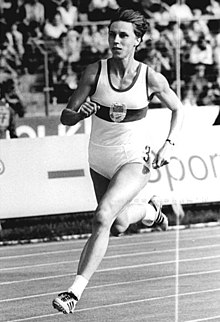
The Track & Field News Athlete of the Year award is given to track and field athletes by Track & Field News magazine, an American sports magazine. A panel of international track and field experts organized by the magazine selects the winners. The award has been given to men since 1959 and women since 1974.
| More selected articles |
Selected article 40
Portal:Sport of athletics/Selected article/40
The javelin throw is a track and field event where the javelin, a spear about 2.5 m (8 ft 2 in) in length, is thrown as far as possible. The javelin thrower gains momentum by running within a predetermined area. Javelin throwing is an event of both the men's decathlon and the women's heptathlon. (Full article...) The javelin throw was added to the Ancient Olympic Games as part of the pentathlon in 708 BC. It included two events, one for distance and the other for accuracy in hitting a target. The javelin was thrown with the aid of a thong (ankyle in Greek) that was wound around the middle of the shaft. Athletes held the javelin by the ankyle, and when they released the shaft, the unwinding of the thong gave the javelin a spiral trajectory.
Throwing javelin-like poles into targets was revived in Germany and Sweden in the early 1870s. In Sweden, these poles developed into the modern javelin, and throwing them for distance became a common event there and in Finland in the 1880s. The rules continued to evolve over the next decades; originally, javelins were thrown with no run-up, and holding them by the grip at the center of gravity was not always mandatory. Limited run-ups were introduced in the late 1890s, and soon developed into the modern unlimited run-up.[7]: 435–436
| More selected articles |
Selected article 41
Portal:Sport of athletics/Selected article/41

The mechanics of the running blades used by South African former Paralympic runner Oscar Pistorius depend on special carbon-fiber-reinforced polymer prosthetics. Pistorius has double below-the-knee amputations and competed in both non-disabled and T44 amputee athletics events. Pistorius's eligibility to run in international non-disabled events is sanctioned by the International Association of Athletics Federations (IAAF).
Pistorius began running in 2004 after a rugby knee injury which led to rehabilitation at the University of Pretoria's High Performance Centre with coach Ampie Louw. His first racing blades were fitted by South African prosthetist Francois Vanderwatt. Because he was unable to find suitable running blades in Pretoria, Vanderwatt ordered some to be made by a local engineer at Hanger Orthopedic Group. These quickly broke, and Vanderwatt referred Pistorius to American prosthetist and Paralympic sprinter Brian Frasure to be fitted for carbon-fibre blades by Icelandic company Össur.
Pistorius's participation in non-disabled international sprinting competitions in 2007 raised questions about his use of running blades, and the IAAF amended their rules to ban the use of "any technical device that incorporates springs, wheels or any other element that provides a user with an advantage over another athlete not using such a device." After initial studies, Pistorius was ruled ineligible for competitions under these IAAF rules. After further research was presented, the Court of Arbitration (CAS) ruled that his running prostheses were not shown to provide a net competitive advantage over biological legs. In 2012, Pistorius qualified for and competed in both the 2012 Olympic Games and the 2012 Paralympic Games using his running blades, becoming the first amputee sprinter to run in the Olympic Games. (Full article...)
| More selected biographies |
Sources
- ^ Each segment of the relay (the distance run by one person) is referred to as a leg.
- ^ "United States Athletics". sports-reference. Archived from the original on 17 April 2020. Retrieved 11 April 2012.
- ^ "Team USA at the Olympic Games". usatf.org. Retrieved 11 April 2012.
- ^ "Hammer Throw". World Athletics. Archived from the original on November 19, 2021. Retrieved May 12, 2022.
- ^ Johannsen, Dana (1 August 2021). "Tokyo 2020: Why the Olympic hammer throw may become a new national obsession". Stuff. Retrieved 1 August 2021.
- ^ "Hammer Throw". World Athletics.
- ^ "Laying Out Sector Angles for the Track and Field Throwing Events" (PDF). USA Track & Field Pacific Northwest. Archived (PDF) from the original on 2015-05-13. Retrieved 2022-03-19.
The shot, discus, hammer & weight throw sector is 34.92º. This angle was chosen due to its simple geometry.
- ^ Jukola, Martti (1935). Huippu-urheilun historia (in Finnish). Werner Söderström Osakeyhtiö.



